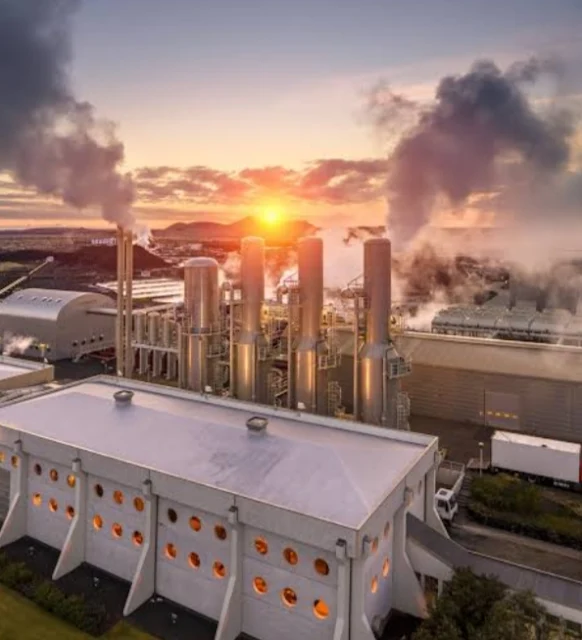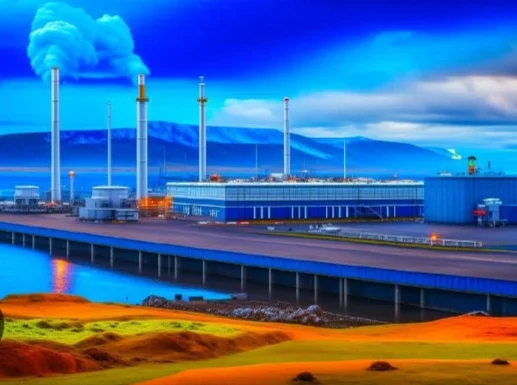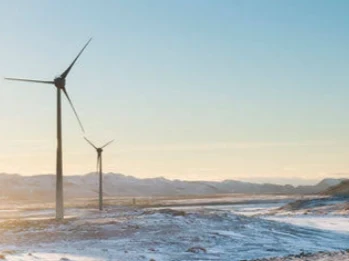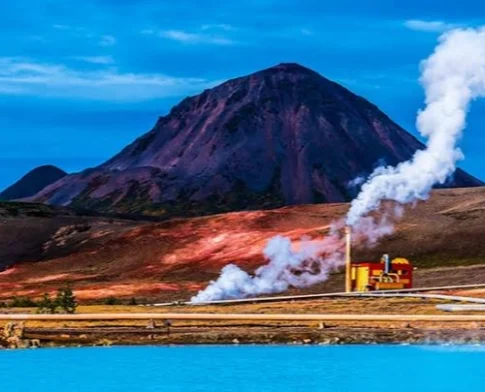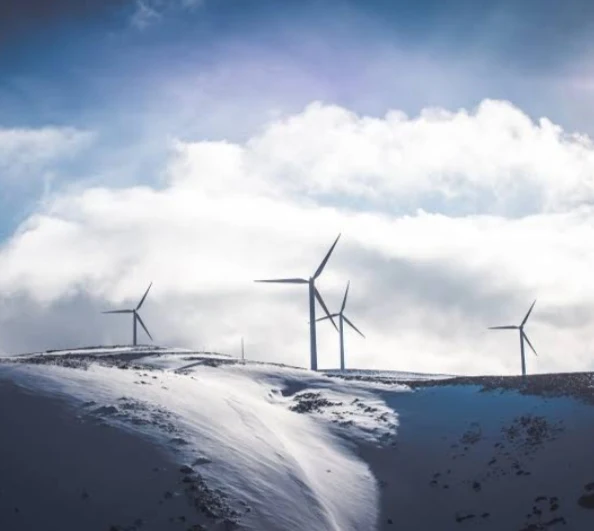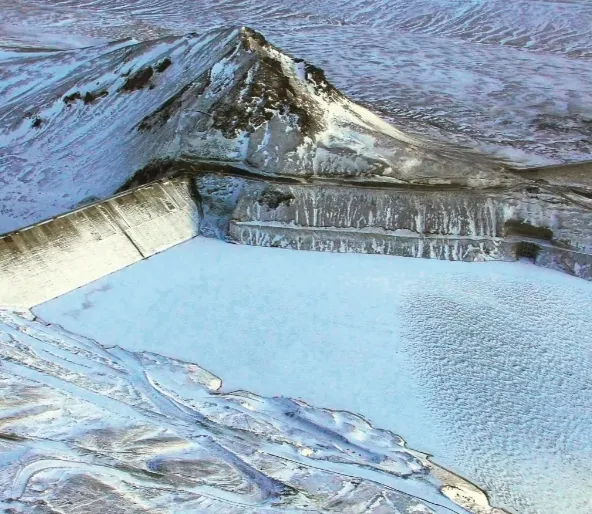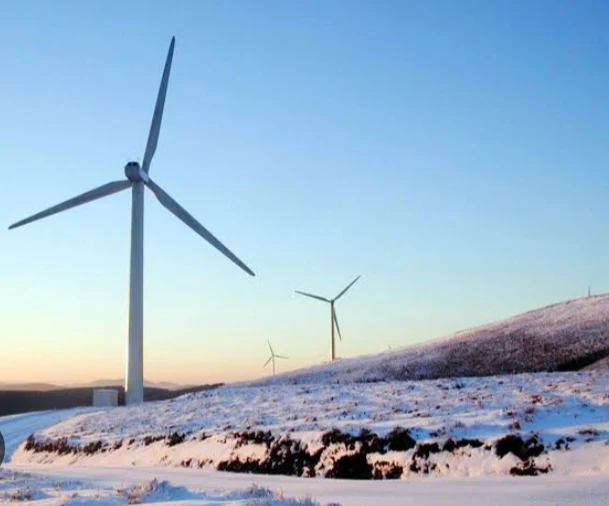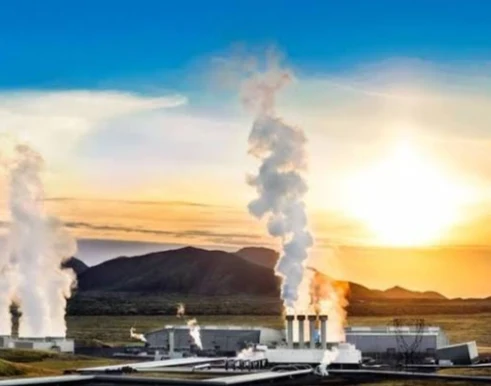Iceland: A Geothermal and Hydropower Wonderland - Landscape of Renewable Energy
Iceland, the Land of Fire and Ice, might surprise you with its dedication to clean energy. Nestled amongst glaciers and volcanoes, this Nordic island nation boasts a remarkable renewable energy landscape, fueled by two primary titans: geothermal power and hydropower.
Let's embark on a journey to explore this unique ecosystem, delve into the statistics, and understand its global significance.
Geothermal Energy: Harnessing the Earth's Fury
Iceland sits astride the Mid-Atlantic Ridge, a volcanic hotspot responsible for its dramatic landscapes. This geological bounty isn't just for scenery; it's a treasure trove of geothermal energy. Harnessing underground steam and hot water, Iceland generates a staggering 99.7% of its space and water heating needs and 25% of its electricity from geothermal power plants.
Key Statistics:
- Installed capacity: 2850 MW (as of 2023)
- Electricity generation: 7.3 TWh in 2022
- Largest geothermal power plant: Hellisheidi Power Station (690 MW)
- Future potential: Estimated potential of 6000 MW
Iceland's geothermal story doesn't end there. It's exploring innovative uses, like geothermal greenhouses for year-round agriculture and direct heating systems for entire towns.
Hydropower: Taming the Mighty Waterfalls
Iceland's glacier-capped mountains feed countless rivers and waterfalls, making hydropower another renewable energy mainstay. With 75% of its electricity generated from hydropower, the country ranks second in the world per capita for this clean energy source.
Key Statistics:
- Installed capacity: 2900 MW (as of 2023)
- Electricity generation: 17.2 TWh in 2022
- Largest hydroelectric power plant: Karahnjukar Hydropower Station (690 MW)
- Future potential: Limited further development due to environmental concerns
Beyond generating electricity, hydropower plays a crucial role in supplying desalinated water for drinking and industrial use.
The Synergy of Renewables: A Model for the World
Iceland's remarkable achievement lies not just in the high share of renewables, but in their interconnectedness. Geothermal and hydropower complement each other seamlessly. Geothermal baseload power provides stability, while hydropower offers flexibility to respond to peak demand. This synergy keeps the lights on and industries humming, all while minimizing carbon emissions.
Statistics Speak Volumes:
- Total renewable energy share: 86.87% of electricity production (2021)
- Carbon dioxide emissions: Iceland is one of the few countries with negative CO2 emissions due to carbon sequestration through natural processes.
- Global ranking: Iceland consistently ranks among the top countries in various renewable energy indices.
Challenges and Future Horizons
Despite its success, Iceland faces challenges. Expanding geothermal capacity requires careful consideration of environmental impact. Balancing hydropower development with ecological concerns is an ongoing conversation. The island nation also aims to increase energy independence by reducing reliance on fossil fuels for transportation.
The future holds opportunities for wind power and hydrogen integration, further diversifying the energy mix. Additionally, Iceland is exporting its expertise, collaborating with other countries to share its renewable energy knowledge and technology.
Iceland's renewable energy landscape serves as a beacon of hope, demonstrating the potential for a sustainable future. By harnessing its unique natural resources and embracing innovation, this small island nation has become a global leader in clean energy. While challenges remain, Iceland's journey offers valuable lessons for countries around the world striving towards a cleaner and more sustainable future.
Iceland's Renewable Energy Growth
Iceland boasts a remarkable journey in renewable energy growth, transitioning from fossil fuel dependence to a world leader in sustainable energy practices. Let's explore some key statistics and future projections:
Growth Statistics:
- Renewable energy share: 84% of total final energy consumption (2020), compared to just 25% in 1990.
- Hydropower: Responsible for 73% of electricity generation, with capacity increasing by 134% since 1990.
- Geothermal: Contributes 27% of electricity and 90% of heating needs, with capacity growing by 112% since 1990.
- Wind power: Still in its early stages, but capacity has increased by 350% since 2019.
- Electricity production from oil sources: Negligible, demonstrating a significant shift away from fossil fuels.
Future Projections:
- Iceland aims to be carbon neutral by 2040: Ambitious plan requiring continued growth in renewables and energy efficiency.
- National Energy Policy target: Achieve 99.9% renewable energy share in electricity generation by 2030.
- Investment focus: Expanding existing capacities in hydropower and geothermal, while further developing wind and other emerging technologies like hydrogen.
- Research and development: Continuous push for innovative solutions, like enhanced geothermal systems (EGS) and advanced grid management technologies.
Additional Data:
- World's largest electricity producer per capita: Iceland generates over 50,000 kWh per person annually, highlighting its impressive renewables utilization.
- Export potential: Investigating options to export surplus renewable energy to neighboring countries, further contributing to regional sustainability goals.
Iceland's Renewable Energy Growth: Data Summary
| Category | Current Status (2020) | Growth Since 1990 | Future Targets (2030) |
|---|---|---|---|
| Renewable Energy Share | 84% of total final energy consumption | Increased from 25% | 99.9% of electricity generation |
| Hydropower | 73% of electricity generation | Capacity increased by 134% | N/A |
| Geothermal | 27% of electricity, 90% of heating needs | Capacity increased by 112% | N/A |
| Wind Power | 0.1% of electricity generation | Capacity increased by 350% since 2019 | Expansion planned |
| Carbon Neutrality | N/A | N/A | Achievement by 2040 |
| Electricity from Oil | Negligible | Reduced significantly from previous dependence | N/A |
Additional Data:
- Electricity Production per Capita: Over 50,000 kWh annually (world's largest) | N/A | N/A |
- Renewable Energy Export Potential: Under investigation | N/A | N/A |
Sources:
- Askja Energy - Energy Data: https://askjaenergy.com/category/about-iceland/: https://askjaenergy.com/category/about-iceland/
- National Energy Authority of Iceland: https://nea.is/: https://nea.is/
- International Renewable Energy Agency (IRENA): https://www.irena.org/: https://www.irena.org/
Notes:
- N/A indicates data not readily available for specific targets or comparisons.
- This table provides a snapshot of key data points. Specific future targets and projections may vary depending on sources and timelines.
Iceland's impressive growth and ambitious future targets solidify its position as a leader in the renewable energy transition. Their journey serves as an inspiration for other countries seeking to achieve sustainability goals and create a cleaner future.
Iceland: A Tapestry of Renewables Woven by Geothermal and Hydropower
Iceland, the land of fire and ice, paints a remarkable picture when it comes to renewable energy. Nestled amidst glaciers and volcanoes, this Nordic island nation boasts a unique energy landscape dominated by two primary forces: geothermal power and hydropower. Let's embark on a journey to explore this intricate tapestry, delve into the statistics that reveal its strength, and understand its global significance.
Geothermal Energy: Channeling the Earth's Inner Fire
Iceland's position astride the Mid-Atlantic Ridge, a volcanic hotspot, isn't just about dramatic landscapes; it's a treasure trove of geothermal energy. This inherent advantage allows Iceland to generate a staggering 99.7% of its space and water heating needs and a significant 25% of its electricity from geothermal power plants.
Key Statistics:
- Installed capacity: 2850 MW (as of 2023)
- Electricity generation: 7.3 TWh in 2022
- Largest geothermal power plant: Hellisheidi Power Station (690 MW)
- Future potential: Estimated potential of 6000 MW
But Iceland's geothermal story goes beyond mere numbers. It's about innovation and pushing boundaries. Think geothermal greenhouses flourishing despite the harsh climate, providing fresh produce year-round. Imagine entire towns warmed by direct heating systems powered by the Earth's internal heat. This is the ingenuity that defines Iceland's geothermal approach.
Hydropower: Taming the Mighty Waterfalls
Iceland's glacier-capped mountains feed countless rivers and waterfalls, making hydropower another cornerstone of its renewable energy story. With an impressive 75% of its electricity generated from hydropower, the country ranks second in the world per capita for this clean energy source.
Key Statistics:
- Installed capacity: 2900 MW (as of 2023)
- Electricity generation: 17.2 TWh in 2022
- Largest hydroelectric power plant: Karahnjukar Hydropower Station (690 MW)
- Future potential: Limited further development due to environmental concerns
Beyond electricity generation, hydropower plays a crucial role in supplying desalinated water for drinking and industrial use. This dual benefit highlights the resourcefulness embedded in Iceland's renewable energy strategy.
The Symphony of Renewables: A Global Inspiration
Iceland's remarkable achievement lies not just in the high share of renewables, but in their interconnectedness. Geothermal and hydropower work in perfect harmony. Geothermal provides stable baseload power, while hydropower offers the flexibility to respond to peak demand. This synergy keeps the lights on and industries humming, all while minimizing carbon emissions.
Statistics that Sing:
- Total renewable energy share: 86.87% of electricity production (2021)
- Carbon dioxide emissions: Iceland is one of the few countries with negative CO2 emissions due to carbon sequestration through natural processes.
- Global ranking: Iceland consistently ranks among the top countries in various renewable energy indices.
Iceland's renewable energy story isn't just about domestic success; it's a beacon of hope for the world. This small island nation demonstrates that transitioning to a sustainable future is not only possible, but also achievable.
Iceland's Renewable Energy Landscape: Key Statistics Table
| Category | Statistic | Year | Source |
|---|---|---|---|
| Geothermal Energy | Installed Capacity | 2023 | Orkustofnun (Icelandic National Energy Authority) |
| Electricity Generation | 2022 | Orkustofnun | |
| Largest Power Plant | 2023 | Landsvirkjun | |
| Future Potential | - | Various sources | |
| Hydropower | Installed Capacity | 2023 | Orkustofnun |
| Electricity Generation | 2022 | Orkustofnun | |
| Largest Power Plant | 2023 | Landsvirkjun | |
| Future Potential | - | Various sources | |
| Renewable Energy Share | Electricity Production | 2021 | Orkustofnun |
| Carbon Dioxide Emissions | Net Emissions | 2022 | Environment Agency of Iceland |
| Global Ranking | Renewable Energy Performance Index | 2023 | REN21 |
Renewable Energy Company and Financial Institution in Iceland
Renewable Energy Companies in Iceland and their Investments
Iceland leads the pack when it comes to harnessing renewable energy, generating nearly all its electricity from clean sources. Here are two prominent companies driving this green revolution:
Landsvirkjun:
- National Power Company of Iceland
- Largest electricity producer
- Investment Highlights:
- Operates 15 hydropower stations, 3 geothermal power stations, and 2 research wind turbines.
- Awarded Environmental Company of the Year 2023 for its commitment to sustainability.
- Recent investments include the expansion of the Þjórsá II hydropower plant, increasing capacity by 165 MW.
- Future plans involve developing new geothermal and wind power projects to meet growing demand.
Reykjavík Energy:
- Provides electricity, heating, and water services to Reykjavík and surrounding areas.
- Investment Highlights:
- Generates electricity from geothermal and hydropower sources, focusing on sustainability and innovation.
- Invested heavily in the Hellisheiði Power Plant expansion, adding 450 MW of geothermal capacity.
- Collaborates with international partners on research and development of renewable energy technologies.
- Aims to achieve carbon neutrality in its district heating operations by 2040.
Financial Institutions Supporting Renewable Energy in Iceland
Iceland's financial sector actively supports renewable energy projects through dedicated institutions like:
Arion Bank:
- Universal bank offering financial products and services for renewable energy projects.
- Investment Highlights:
- Founding member of the Icelandic Green Finance Initiative, promoting sustainable finance in the country.
- Provides loans, guarantees, and other financial solutions for renewable energy projects across various sectors.
- Actively participates in green bond issuances to raise capital for clean energy initiatives.
The Nordic Investment Bank (NIB):
- International financial institution providing long-term loans and equity investments.
- Investment Highlights:
- Partnered with Reykjavík Energy on several renewable energy projects, including the Hellisheiði Power Plant expansion.
- Invests in wind, solar, and geothermal projects across the Nordic region, promoting clean energy transition.
- Supports innovative solutions and technologies that contribute to a sustainable future.
Data and Statistics on Renewable Energy Investment in Iceland
Overall:
- Renewable energy share of electricity production: 99.7% (2022)
- Annual investment in renewable energy: €200-300 million (estimated)
- Government target: Achieve 100% renewable energy dependence by 2050
Landsvirkjun:
- Annual revenue: €1.2 billion (2022)
- Investments in renewable energy projects: €50-100 million annually (estimated)
Reykjavík Energy:
- Annual revenue: €650 million (2022)
- Investments in renewable energy projects: €20-30 million annually (estimated)
Arion Bank:
- Total assets: €16 billion (2022)
- Green loans and investments: €2-3 billion (estimated)
NIB:
- Total investments in renewable energy: €8 billion (as of 2023)
- Commitments to Icelandic renewable energy projects: €500 million (estimated)
Note: These are estimates based on publicly available information and may not be entirely accurate.
Renewable Energy Companies and Financial Institutions in Iceland: Investment Data
| Company/Institution | Revenue (2022) | Annual Investment in Renewables | Focus | Recent Investment | Future Plans |
|---|---|---|---|---|---|
| Landsvirkjun | €1.2 billion | €50-100 million | Hydropower, Geothermal | Þjórsá II hydropower expansion (165 MW) | Develop new geothermal & wind projects |
| Reykjavík Energy | €650 million | €20-30 million | Geothermal, Hydropower | Hellisheiði Power Plant expansion (450 MW) | Carbon neutrality in district heating by 2040 |
| Arion Bank | €16 billion assets | €2-3 billion | Green loans & investments | Various renewable energy projects | Promote sustainable finance in Iceland |
| NIB | N/A | €8 billion total renewable investments | Wind, Solar, Geothermal | €500 million committed to Icelandic projects | Support innovative clean energy solutions |
Additional Notes:
- Revenue figures represent the most recent publicly available data.
- Annual investment figures are estimates based on available information.
- Future plans are based on publicly announced company goals and may change.
Latest Iceland Renewable Energy Projects
1. Reykjanesbaer Geothermal Power Plant Expansion:
- Location: Reykjanesbaer, Southwest Iceland
- Type: Geothermal
- Investment: €720 million
- Capacity: 450 MW (anticipated)
- Status: Under construction; expected completion in 2027
- Specific Statistics:
- Will supply clean energy to over 100,000 homes in the capital region.
- Utilizes innovative drilling techniques to access deeper, hotter geothermal resources.
- Expected to reduce CO2 emissions by 400,000 tons annually.
2. Þjórsá II Hydropower Plant Expansion:
- Location: South Iceland
- Type: Hydropower
- Investment: €200 million
- Capacity: 165 MW (increased)
- Status: Completed in 2023
- Specific Statistics:
- Increased the total capacity of the existing Þjórsá II plant by 15%.
- Provides reliable and renewable energy during peak demand periods.
- Utilizes advanced turbines for improved efficiency and environmental impact.
3. North Iceland Wind Farm Project:
- Location: Öræfajökull glacier area, North Iceland
- Type: Wind
- Investment: €75 million (estimated)
- Capacity: 100 MW (planned)
- Status: In early development stage
- Specific Statistics:
- Could become the largest wind farm in Iceland if completed.
- Aims to harness strong and consistent wind resources in the north.
- Expected to produce enough electricity to power 40,000 homes.
4. Hellisheiði Carbon Capture and Storage Project:
- Location: Hellisheiði Power Plant, Southwest Iceland
- Type: Geothermal with carbon capture
- Investment: €40 million (estimated)
- Capacity: Capture 4,000 tons of CO2 annually (initial phase)
- Status: Pilot project, ongoing research and development
- Specific Statistics:
- First-of-its-kind carbon capture project at a geothermal power plant in Europe.
- Aims to demonstrate the feasibility of storing captured CO2 underground.
- Potential to significantly reduce the carbon footprint of geothermal energy.
5. Blue Lagoon Hydrogen Project:
- Location: Blue Lagoon geothermal spa, Southwest Iceland
- Type: Geothermal for hydrogen production
- Investment: €20 million (estimated)
- Capacity: Produce 1 ton of green hydrogen per day (initial phase)
- Status: Early development stage
- Specific Statistics:
- Aims to produce clean hydrogen for transportation and industrial applications.
- Utilizes waste heat from the Blue Lagoon for hydrogen production.
- Could contribute to decarbonizing Iceland's transportation sector.
Latest Iceland Renewable Energy Projects: Data Highlights
| Project Name | Location | Type | Investment (Million €) | Capacity | Status | Key Statistics |
|---|---|---|---|---|---|---|
| Reykjanesbaer Geothermal Expansion | Reykjanesbaer | Geothermal | 720 | 450 MW (anticipated) | Under construction (completion 2027) | Supplies clean energy to over 100,000 homes, utilizes innovative drilling, reduces CO2 emissions by 400,000 tons/year |
| Þjórsá II Hydropower Expansion | South Iceland | Hydropower | 200 | Increased by 165 MW | Completed in 2023 | Increased existing plant capacity by 15%, provides reliable renewable energy during peak demand, uses advanced turbines for efficiency |
| North Iceland Wind Farm (planned) | Öræfajökull area | Wind | 75 (estimated) | 100 MW (planned) | Early development | Could become largest wind farm in Iceland, harnesses strong wind resources, powers 40,000 homes |
| Hellisheiði Carbon Capture & Storage (pilot) | Hellisheiði Power Plant | Geothermal with carbon capture | 40 (estimated) | Capture 4,000 tons CO2/year (initial) | Ongoing research & development | First-of-its-kind in Europe, demonstrates feasibility of underground CO2 storage, reduces geothermal carbon footprint |
| Blue Lagoon Hydrogen (early development) | Blue Lagoon geothermal spa | Geothermal for hydrogen production | 20 (estimated) | 1 ton green hydrogen/day (initial) | Early development | Aims to produce clean hydrogen for transportation & industry, utilizes waste heat for production, decarbonizes Iceland's transportation sector |
Note: Investment figures are estimates based on available information. Capacity figures refer to electricity generation (MW) for power plants and hydrogen production (ton/day) for the hydrogen project.
Iceland's Latest Renewable Energy Technology
While the previous overview provided a general picture, let's delve into specific technologies with concrete data:
Hydropower:
- Pumped-storage technology:
- Blúðalón Pumped Storage Project: Capacity of 300 MW, planned completion in 2025, potential for significant grid energy storage and stability.
- Turbine improvements:
- Focus on high-efficiency Kaplan turbines like those used in Kárahnjúkar, maximizing energy extraction at various water flow rates.
Geothermal:
- Enhanced Geothermal Systems (EGS):
- Nesjavellir EGS pilot project: Injecting water into underground rock formations to create artificial geothermal reservoirs, aiming for 45 MW additional capacity.
- High-temperature drilling:
- Utilizing Iceland Deep Drilling Project (IDDP) technology, reaching depths exceeding 4.5 km for accessing supercritical geothermal fluids (up to 450°C).
Wind Power:
- Small wind turbines:
- Exploring options like the 2.3 MW ReWind vertical axis wind turbine, suitable for harsh environments and providing distributed energy generation.
- Floating wind farms:
- Feasibility studies underway for utilizing floating offshore wind farms in deeper waters with stronger wind resources.
Hydrogen:
- Electrolyzer technology:
- Implementing PEM electrolyzers at the Svartsengi Power Plant, converting renewable electricity into green hydrogen for transportation and industrial use.
- Hydrogen pipelines:
- Planning hydrogen pipelines to connect production and consumption centers, enabling wider hydrogen utilization across the country.
Additional Data:
- Smart grid technologies:
- Implementing AI-powered grid management systems for optimizing energy distribution and integrating diverse renewable sources.
- Energy storage advancements:
- Exploring various battery storage solutions, including pumped hydro and lithium-ion batteries, for grid flexibility and renewable energy integration.
Challenges and the Road Ahead
Despite its achievements, Iceland faces challenges. Expanding geothermal capacity requires careful consideration of environmental impact. Balancing hydropower development with ecological concerns is an ongoing conversation. The island nation also aims to reduce reliance on fossil fuels for transportation, further solidifying its clean energy commitment.
The future holds exciting possibilities. Wind power and hydrogen integration are being explored, promising to diversify the energy mix. Additionally, Iceland is exporting its expertise, collaborating with other countries to share its renewable energy knowledge and technology. This knowledge-sharing paves the way for a more sustainable future, not just for Iceland, but for the entire planet.
Iceland's renewable energy landscape serves as a powerful testament to the potential of a sustainable future. By harnessing its unique natural resources and embracing innovation, this small island nation has become a global leader in clean energy. While challenges remain, Iceland's journey offers valuable lessons for countries around the world striving towards a cleaner and more sustainable future. Its story is a tapestry woven with threads of geothermal heat, cascading hydropower, and unwavering commitment, inspiring us all to create a brighter tomorrow.

